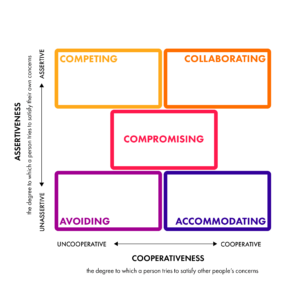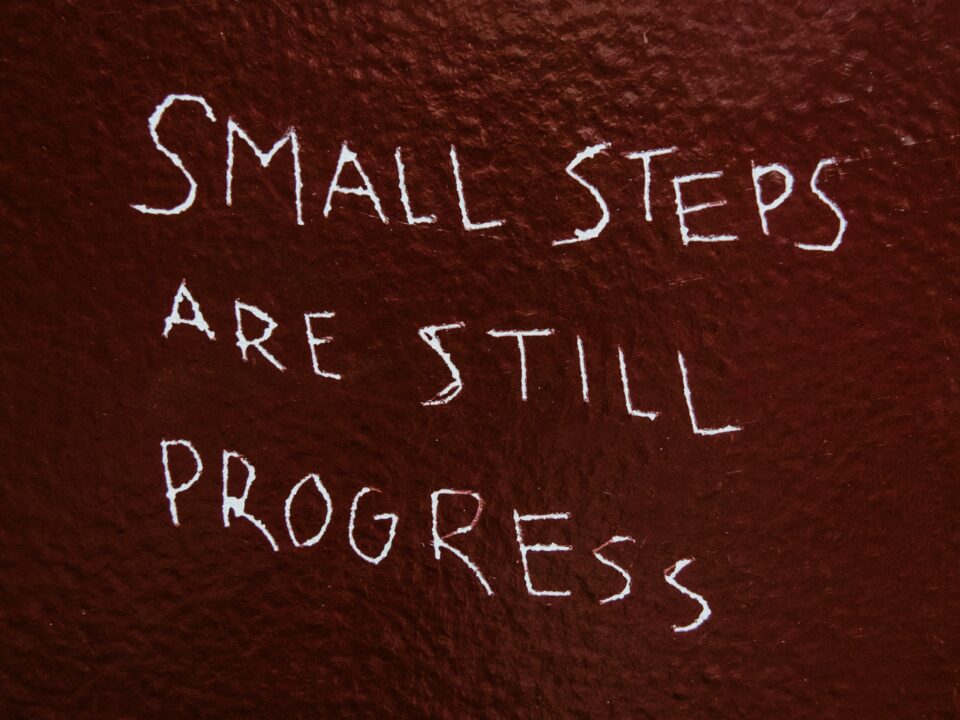
Conflict is Good
April 18, 2022
Preparing Perfect Presentations
June 6, 2022In the last blog, we discussed how conflict, if carefully handled in a timely manner, can actually be beneficial to businesses. (link – conflict is good) This time, we’ll focus on the Thomas-Kilmann model, which outlines a range of responses conflict can elicit in people and how managers can actively tailor their responses to be more appropriate – and ultimately more successful – in resolving the issue.
If you’re dealing with conflict, you’re bound to have your own personal preferences for how you approach the situation. It’s important, though, to make an informed choice about whether the route you are taking is the right one for the issue in hand – not just the one that sits more naturally with your own inclinations. Conflict can engender a primitive stress response – fight or flight – but there are more options open to us that may well be more fruitful in terms of resolution.
The Thomas-Kilmann Instrument (TKI) can be extremely helpful in resolving a conflict. Developed to help people to understand the impact of differing approaches in conflict management, it’s a tool that lays out five different modes of conflict-handling and communicating. By actively choosing a conflict mode appropriate to each individual situation, we’re more likely to be able to fully solve the problem.
Source : https://www.psychometrics.com/wp-content/uploads/2020/09/TKI-conflictmodes-01.png
Each of the five modes – competing, avoiding, accommodating, compromising, and collaborating – can be characterised by how highly they register on the two scales – assertiveness and co-operativeness. The modes each have a series of associated skills which are required in order to action them. None of the modes are wrong to use, but according to Thomas-Kilmann, there are appropriate times to use them.
1 – Competing
A competing conflict mode registers highly on the assertiveness scale and low in terms of co-operation. It is an appropriate response if quick action needs to be taken, when a potentially unpopular decision needs to be made and when one’s self-interests need to be protected.
Perhaps you have to insist someone works at a weekend to meet a deadline and they don’t want to. Or two people in your team want to book the same week’s holiday and things won’t function if you agree to both of their requests. Your ultimate decision in solving these issues may well be unpopular, but you are going to have to resolve it by coming down on one side and accepting the fall-out. The buck stops here.
Skills needed for the competing mode include:
- Arguing and debating
- Being able to state your position clearly
- Standing your ground
- Asserting your opinions and feelings
- Using your position or influence
2 – Avoiding
In terms of assertiveness and co-operation, the avoiding mode is low on the scale. It’s a helpful tactic to employ with low-importance conflict, if you want to buy some time and to reduce tensions. Avoiding can be seen as a poor choice and a sign of weakness or lack of confidence; as a result, many managers are reluctant to use this tactic. However, as a conscious choice, avoiding conflict can be a highly appropriate response.
Perhaps you’ve been asked to mediate between members of your team – an avoidance response would be to ask them to attempt to resolve the issues themselves first. Or maybe you’ve been asked to intervene by members of another team who have an issue with their line manager. Avoidance would be a good choice here because your input into another manager’s team is inappropriate and potentially undermining. Instead you might encourage the aggrieved team members to raise the issue with the person in question and go to their line manager if they are not subsequently satisfied.
Avoiding is also useful in situations for which you are not ultimately responsible or do not have the authority to resolve the conflict.
Relevant skills for this mode are:
- The ability to side-step issues
- The ability to leave things unresolved
- A good sense of timing
- The ability to withdraw
Some people can find withdrawing from conflict hard to achieve, because they are ‘fixers’ and prefer to tie up loose ends. Sometimes, leaving things unresolved is the best choice; it allows others to find their own way through a conflict.
3 – Accommodating
Low on the assertiveness scale and high in terms of co-operation, the accommodating mode can be used where it is appropriate to be reasonable, to help develop performance, to create a feeling of goodwill and to keep the peace during situations where conflict might otherwise flare up. For example – if a supplier didn’t complete work to a satisfactory standard, they may do something in the future for free by way of compensation. Another example could be a team member with some free time takes on a busy colleague’s project.
A word of warning about using this mode: occasionally people can keep a tally of their ‘accommodations’ in the expectation that the favour will be returned in the future. If this is not made clear to the other party, conflict can actually arise. Clarity of communication between all parties involved in this mode is imperative.
To facilitate the accommodating mode, you need to have the following skills:
- An ability to forget what you want
- Selflessness
- An ability to yield
- Ability to obey orders
- Ability to compromise
4 – Compromising
Sometimes defined as a conflict situation where both parties win, this mode registers as moderate on both the assertiveness and co-operativeness scales. Compromising is an appropriate conflict resolution method when dealing with issues of moderate importance, in situations where the parties have equal hierarchical status, where there are time constraints – a temporary fix – and where there is a strong commitment to find a resolution.
Skills needed for compromising:
- Negotiating
- Assessing value
- Finding a middle ground
- Ability to make concessions
5 – Collaborating
With high levels of assertiveness and co-operativeness, this mode is a creative solution which is built using multiple people’s input. The downside is that collaboration needs time and energy to facilitate. However, some conflicts do warrant the level of input that collaborating requires: when the conflict is important to those who are trying to construct an integrated solution, when perspectives or ideas need to be merged, in gaining commitment from people and when attempting to improve relationships.
If, for example, you have an issue that has a major impact – moving site, perhaps, with the resulting fall-out on your people’s lives – it’s vital that stakeholders are consulted. If the debate is about something more minor, like where to have lunch – then it’s not going to be worth spending time and effort collaborating to resolve the issue.
It’s worth highlighting the difference between collaborating and compromising; Compromising is a mixture of existing solutions; collaborating means arriving at a new solution. Collaborating potentially involves everyone; compromising solutions can have input from as little as two parties.
Skills necessary for collaborating:
- Active listening
- The ability to manage non-threating confrontation
- The ability to identify concerns
- Analysis of people’s input
Using a tool like the TKI can be helpful in providing managers with a range of options to resolve conflict effectively and appropriately, rather than relying on instinct and personal inclination.
Cube Learning and Development delivers bespoke, personal coaching programmes which can help train managers in conflict resolution. For a no-obligation chat about this and our other training, call Chris Burton on 07879 602002.





